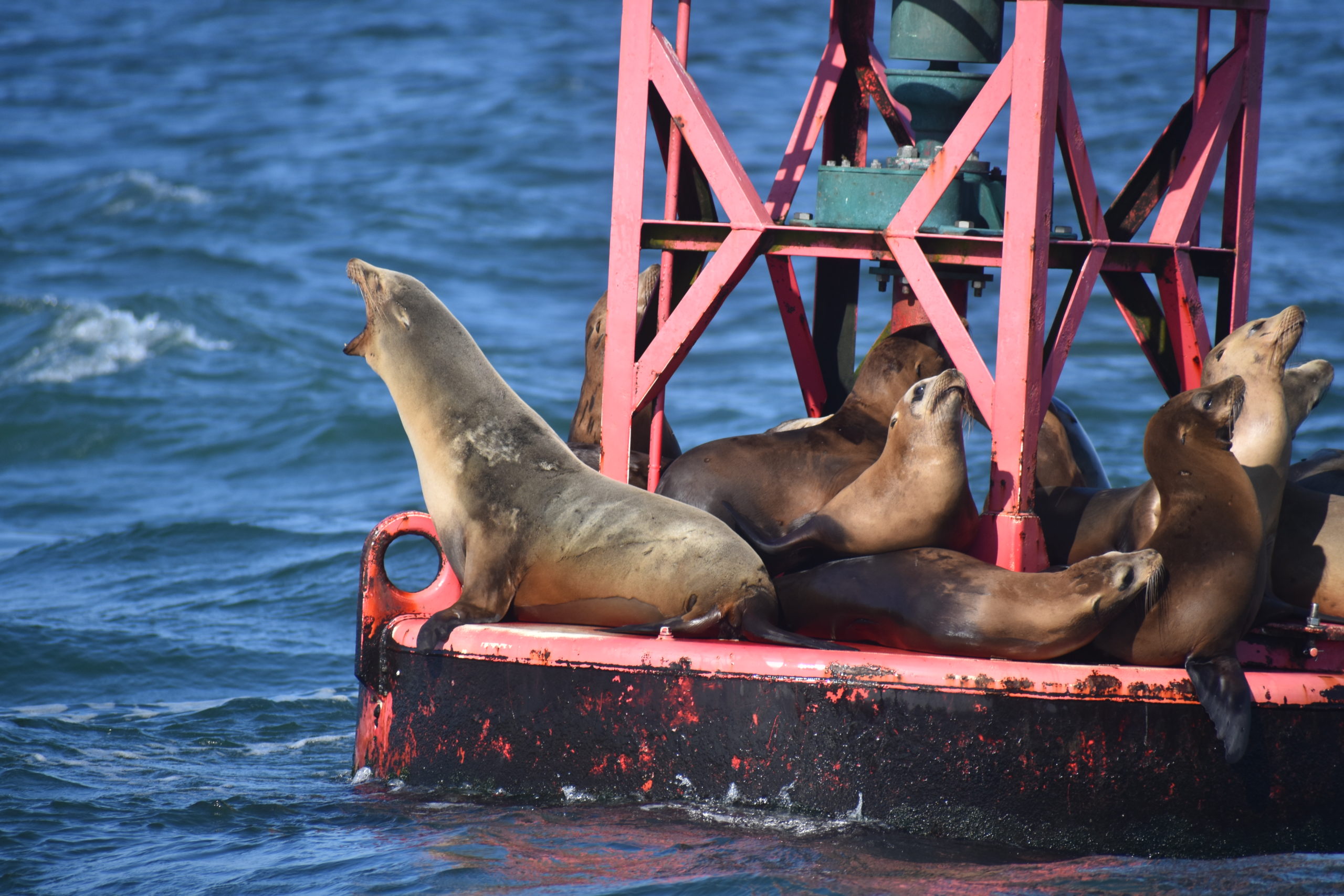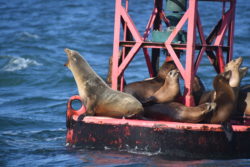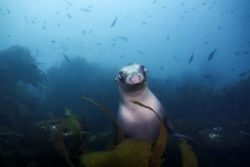
Sea Wonder: California Sea Lion

California sea lions hauled out on a buoy in Greater Farallones National Marine Sanctuary. Photo: Sara Heintzelman
The California sea lion (Zalophus californianus) is one of the most well-known species of pinnipeds in the world. As their name suggests, they are common along California’s rocky coastline and often seen in zoos and aquariums. There is a lot to love about these marine mammals, including their dog-like appearance, funny sounding vocalizations, and seemingly lazy nature.
Description
California sea lions are known as otariids or eared seals, which is made obvious by the visible ear flaps located on each side of their heads. Their snouts are dog-like with a nose that remains shut except for when breathing and a set of thick whiskers called vibrissae, which they use to detect movements in the water. When dry, California sea lions are light brown in color and when wet, they appear much darker. Their fur is incredibly thick and helps them regulate their body temperatures in the cold waters of the Pacific Ocean and California’s sometimes chilly beaches. They have two fore flippers, which they can use to steer and stop while swimming or to help them navigate land, and two sets of rear flippers, which they use to swim and rotate under their bodies for walking on shore. Their hind flippers feature three to five nails similar to those you would see on a dog.
Males and females are sexually dimorphic, meaning their body shapes and sizes differ significantly. Females tend to be shorter and slenderer, reaching maximum weights of around 240 pounds and lengths of about six feet. Males are much larger, weighing as much as 700 pounds and reaching lengths of nearly eight feet; they also grow a sagittal crest (ridge of bone) on top of their heads when sexually mature. Sea lion pups are about 16 pounds at birth and have very dark brown coats, which they molt and replace with a blonde or silver appearing coat after four or five months of life. Most of a sea lion’s weight is blubber, a thick fat layer that insulates their bodies and regulates their temperatures in their colder ambient environment. In the summer, they molt their thicker coats in favor of thinner ones and spend more time in cooler waters to keep themselves from overheating. They also eat and weigh less in the spring and summer months than they do in the fall and winter.

California sea lion in Monterey Bay National Marine Sanctuary. Photo: Douglas Croft
Diet & Habitat
California sea lions are strict carnivores, meaning they survive only off other animals. They generally feed offshore and have a large variety of prey. They are opportunistic feeders, meaning they pursue whatever is the easiest to catch, which might include squid, anchovies, sardines, rockfish, and herring. They can dive as deep as 900 feet below the surface (but often don’t go past 250 feet) and hold their breaths for around 10-12 minutes. They can swim at burst speeds of about 13 miles per hour but more often cruise at about 1.5 miles per hour; the fastest recording sea lion swim speed is about 30 miles per hour! To survive in colder waters, these sea lions can slow their heart rates and restrict their circulation away from their exposed flippers to avoid hypothermia.
California sea lions live exclusively along America’s West Coast. They travel the shallower coastal waters of the North Pacific and use sandy beaches and rocky shores for breeding and resting. They often use marinas, jetties, buoys, and other human-made structures as safe-havens as well. Their range spans as far north as Alaska and as far south as Mexico’s central Pacific coast. In the National Marine Sanctuary System, California sea lions can be seen in or near Olympic Coast, Greater Farallones, Cordell Bank, Monterey Bay, and Channel Islands national marine sanctuaries. Female sea lions generally don’t migrate far from where they are born but will travel as far as necessary to find food, which leads to some pups being abandoned during their critical months. Males, however, travel much farther north in the summer to forage. When cooling themselves, they often participate in rafting behavior where they hold their flippers above the water for long periods of time, which is often mistaken for injury or entanglement.
Life History
California sea lion pups are born on land or in water during the warmer months, where they nurse from their mothers and quickly learn to eat solid foods before going off on their own. Adult males, known as bulls, establish breeding groups that include upwards of a dozen females, using aggressive physical displays and intimidating vocalizations to attract females and defend their colonies from other males. Females generally breed with only one male per season. A California sea lion pregnancy lasts for about 11 months, with the majority of pups born between June and August. Several weeks after giving birth, a female can enter estrus and become pregnant again.
Sea lion pups learn to tell their mothers from other sea lions by their unique vocalizations and smells, which is a useful skill to know in a rookery of several hundred individual sea lion pups and their parents! For the first six months to year of life, sea lion pups stay close to and observe their mothers as they learn to navigate, hunt and eat solid foods, and learn sea lion social behaviors. After that first year, juvenile sea lions leave and become independent, sometimes traveling farther away to live near a new colony, and other times staying close to their home colonies. California sea lions reach sexual maturity when they are fully grown, which is around four or five years old. California sea lions are highly social with each other and are sometimes seen resting with or near other marine species like seals, turtles, and birds.
Threats & Conservation
Like all marine mammals in U.S. waters, California sea lions are protected under the Marine Mammal Protected Act of 1972. While they were once hunted for their fur, populations have rebounded and continue to increase as a result of these legal protections. Entanglement and interactions with fisheries – sometimes accidental and sometimes a result of sea lions trying to steal fish from nets and other gear – is one of the leading threats to California sea lion populations. Other threats include domoic acid poisoning, ocean pollution, human interaction, ship strikes, and climate change, which can lead to heat strokes or cause their prey to move farther and farther offshore, increasing the possibility of starvation or pup abandonment.

Young California sea lion swimming in Channel Islands National Marine Sanctuary. Photo: Beata Lerman
